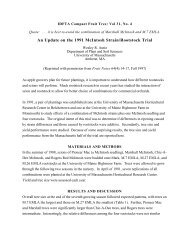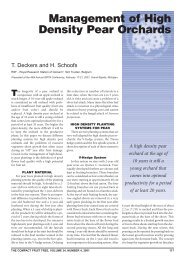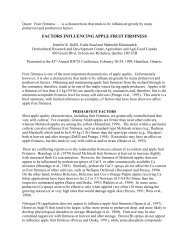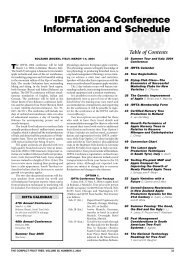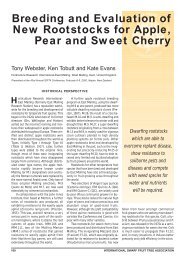You also want an ePaper? Increase the reach of your titles
YUMPU automatically turns print PDFs into web optimized ePapers that Google loves.
varieties differing in habits, vigor and productivity.The cultivars were Noire deMeched, Fercer, Lapins and StarkingHardy Giant. One year later, Regina wasadded. All varieties are grafted on Tabel®Edabriz (Prunus cerasus, Asiatic type). Tohave equal start conditions for the twotraining systems, all trees were cut down to70 cm (28 inches) above the soil level. Onlyin a density of 5000 trees/ha (2024 trees/acre) for the spindle system heading wasavoided. For having a weaker growth of thebasal side limbs, all side buds above 90 cm(35 inches) were removed by sparing theterminal bud.The two training systems are the slightlyoblique 30˚ V spindle, attached to abamboo pole in a 30˚ V construction andthe 60˚ V-shaped trellis hedge. The latterdiffers from the Australian Tatura trellis(Y-shaped) by individual trees being inclinedalternately from one side to theother (van den Ende and Chalmers, 1975).Depending on the planting distance thenumber of trees per treatment unit variedbetween 7 and 21.The whole trial was covered by two differentrain shelter constructions. Since1997, plastic was spread out not only duringripening time for about 5 to 6 weeksbut also at bloom as a frost shelter.MeasurementsFor the performance of the plantingsystem standard measurements are carriedout as follows: Yearly crop per tree separatedinto intact, cracked and rotten fruits.Rotten fruits with cracks are placed in theclass of cracked fruits. Productivity is expressedin kg per stem circumference, fruitsize by average weight of one fruit from asample of 50 fruits (Schmidt et al., 1985).Flesh firmness is measured by the FrenchDurofel instrument (a dynamometer witha bolt of 0.25 cm 2 ) (Planton, 1992).The whole plot is fertigated and soilmoisture controlled by watermark tubes.RESULTSAfter planting in March 1994, the firstcrop was picked in 1996. Due to the preliminarycharacter of the study, only yielddata, losses by cracking and rotting, firmnessand fruit weight are shown.YieldThe mean yield values of four varietiesshow increasing crop correlated with increasingplanting density for both 1996and 1997 (Table 2). The V 60˚ hedge had alower average yield than the V 30˚ spindle.In 1998 + 1999 it was the opposite, but in2000 the spindle had advantages (Table 3).The yield development is very characteristicfor each training system: While the 30˚spindle is increasing continuously, the 60˚trellis hedge had decreasing yields in 2000(Fig. 1 and Fig. 2). There were also differencesdepending on the four varieties(Table 4): Fercer had its first yield only int/ha2520151050▲●■◆■▲●◆FIGURE 1●▲■◆the fourth growing season and Lapins wasthe most productive variety. The doublerange (DR) V 60˚ had a decidedly low yieldin 1997 because this range was not coveredat bloom.Yields of 30˚ spindle plantings at four tree densities from 1996 to 2000; mean values of 4●▲■◆▲■1996 1997 1998 1999 2000●▲◆■●▲◆■●▲■◆FIGURE 2▲■◆◆■▲●◆◆▲■●V 30˚,1666treesV 30˚,2500treesV 30˚,DR3333treesV 30˚,5000treesYields of 60˚ hedge plantings with four tree densities from 1996 to 2000; mean values of 4t/ha25201510501996 1997 1998 1999 2000●●◆▲■●V 60˚,1666treesV 60˚,2500treesV 60˚,DR3333treesV 60˚,5000treesTHE COMPACT FRUIT TREE, VOLUME 34, NUMBER 3, <strong>2001</strong> 75



